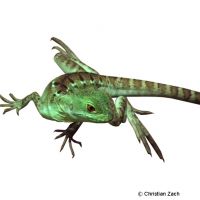Chinese Water Dragon (Physignathus cocincinus)
| Chinese Water Dragon Physignathus cocincinus | |
|---|---|
| Name | Chinese Water Dragon |
| Name Lat. | Physignathus cocincinus |
| Family | Agamas |
| Family lat. | Agamidae |
| Order | Scaled Reptiles |
| Order lat. | Squamata |
| Origin | Southeast Asia |
| Habitat | Shore areas |
| Diet | Insects, vegetables, fruits |
| Humidity | 70-90 % |
| Behavior | ♂ territorial |
| Keeping | Individual, pair, harem |
| Care Level | Difficult |
| Reproduction | Oviparous |
| Housing | Aquaterrarium |
| Life Span | 15-18 years |
| Protection | EU Annex D |
| Metric Units | |
| Size | 80 cm |
| Temperature | 27-30 °C |
| Temperature Local | 35 °C |
| Housing Size | 200 x 120 x 160 cm |
| US Units | |
| Size | 31" |
| Temperature | 81-86 °F |
| Temperature Local | 95 °F |
| Housing Size | 80" x 45" x 65" |
Distribution and habitat
The distribution area of the diurnal green water dragon stretches from Thailand over Vietnam to South China where it lives at water edges overgrown with trees and bushes.
Maintenance
Minimum dimensions for the terrarium, according to the size and number of animals
| 1-2 animals | 5KRL x 3KRL x 4KRL (L x W x H) |
Head-torso length (KRL) is measured on the largest animal. For each additional animal, increase the footprint by 15%. A terrarium of e.g. L 200 x W 120 x H 160 cm is recommended, which should be placed in a quiet and vibration-free place
They need a spacious terrarium, structured with strong, firmly mounted climbing branches, horizontal resting places and hiding places, with a substrate of leaf-soil-peat mixture (terrarium humus) and a generous planting (e.g. Platycerium, Scindapsus, Ficus). Absolutely necessary is a heated (approx. 25 °C), easy to clean water basin for bathing, with a water depth of 30-40 cm. Half of the substrate must be kept moist at all times. They should be sprayed with lukewarm water 1-2 times a day, but a rain or mist system is better.
| Temp. day: 27-30 °C | Temp. night: 20-22 °C | Temp. local: up to 35 °C | Humidity: 70-90 |
The lighting duration must be 12-14 hrs. Special lamps with high UV-A and UV-B content are ideal, because daily UV irradiation is essential.
Diet
They need animal and vegetable food. The food supply consists of large insects, fish, shrimp, shellfish meat, earthworms and the eggs of small birds, and mice for adults, supplemented with commercial ready-made food for insectivorous reptiles. In addition, they need, individually varying, tomatoes, lettuce, dandelion flowers and sweet fruit (grapes, bananas, pears, cherries, melons, etc.). It is important to regularly add minerals and vitamins (dusting the feed). Young animals should be offered food daily, adults 4-5 times a week. Drinking water must always be available
A regular and varied diet promotes health and prevents deficiency symptoms.
Reproduction and breeding
Beginning at 12 months of age, males develop distinct femoral pores (glandular openings) on the inner thighs and a pronounced crest on the head, back, and base of the tail.
The female buries her eggs (5-20 eggs) in the substrate (substrate suitable for digging). The incubation period is 60-100 days at a temperature of 27-30 °C. Suitable initial food for the young is small insects such as fruit flies, flies, micro-heimies and mealybug larvae
Life expectancy can be 15-18 years.
Species protection
Species protection: EU Appendix D, monitoring of trade relevance (monitoring).
Your pet store will be happy to provide you with further information.
Important
The green water dragon is capable of tail regeneration. Adult males behave territorially and are incompatible with each other
For the resting phase, the lighting duration is shortened by 2-3 hours and the temperature is lowered by 3-4 °C for approx. two months.
The terrarium must have good ventilation without drafts and meet the species-specific needs. Measuring devices such as thermometers, hygrometers, etc. are necessary. The lighting has to correspond to the species-specific day-night rhythm and has to be placed in such a way that the animals cannot injure themselves. The terrarium should be locked in such a way that neither unauthorized persons can open it nor the animals can escape. Contamination must be removed regularly
Further literature can be found in your pet store.
References
Text: petdata; Image: Christian Zach
Source: BMELV (1997): Mindestanforderungen an die Haltung von Reptilien; ENGELMANN (2006): Zootierhaltung - Tiere in menschlicher Obhut: Reptilien und Amphibien, Harri Deutsch Verlag
- Gemäß § 21 Abs. 5 Tierschutzgesetz idgF
